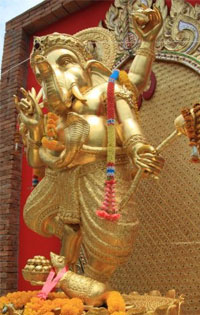Chiang Mai Travel Guide
 Chiang Mai is the second-biggest province of Thailand after Bangkok; the province is bordered by Lamphun and Tak on the south, Chiang Rai, Lampang and Lamphun on the east and Mae Hong Son on the west. In the north Chiang Mai borders Shan State of Myanmar. Chiang Mai is situated at about 310 meters above sea level, on the Mae Ping River basin, Ping is the most important river in Chiang Mai and it flows along for 540 km. from North to South.
Chiang Mai is the second-biggest province of Thailand after Bangkok; the province is bordered by Lamphun and Tak on the south, Chiang Rai, Lampang and Lamphun on the east and Mae Hong Son on the west. In the north Chiang Mai borders Shan State of Myanmar. Chiang Mai is situated at about 310 meters above sea level, on the Mae Ping River basin, Ping is the most important river in Chiang Mai and it flows along for 540 km. from North to South.
Chiang Mai is 696 kilometers north from Bangkok and covers an area of 20,000 square meters, Almost 70% of the area of Chiang Mai is surrounded by high mountains ranges, covered with forests and lush countryside. Mountains generally are located in the north; these form the sources of several tributaries and streams which provide the water necessary to Chiang Mai’s agriculture. There are many National Parks which are still fertile and verdant with plentiful wildlife and exotic flora. Doi Inthanon National Park hosts the Thailand’s highest mountain Doi Inthanon, which stands 2,565 meters above sea level. Ob Luang National Park is easily accessible from the capital.
Chiang Mai is home of different minority groups including the Lua, Mon, Karen, Lahu, Yao, Lisu, Akha, Hmong and Muser people. Many of these tribes maintain their traditional lifestyles. Many foreign visitors prefer to visit to study the way of life of this villages. Today, Chiang Mai is the political, economic, geographical, cultural and tourism capital of Northern Thailand (Lanna), due to its excellent infrastructure with international direct flight connections to inside the country and other countries in the region including China, Singapore, Malaysia, Burma, Cambodia and Taiwan. Flying to Chiang Mai is easy and cheap, flight time is about one hour; the city is also easily accessible by train and by bus.

Chiang Mai offers great adventure opportunities with jungle tours, mountain bike riding, river rafting, elephant riding, mountain trekking. It is also a good starting point to explore nearby locations like Doi Saket, Chiang Dao, Pai, Soppong, Mae Salong, Mae Hong Song, Chiang Saen and Mae Chaem. The city is also developing a reputation as a centre for health and spa resorts. Hospitals provide medical treatments and guarantee complete safety of tourists and locals.
